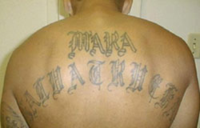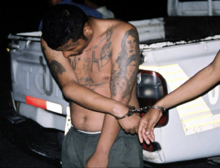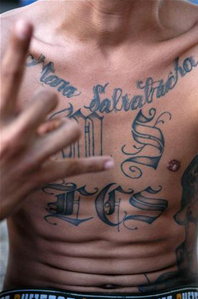MS-13
 Mara Salvatrucha gang member with gang's name tattooed on his back | |
| Years active | 1980s–present |
|---|---|
| Territory | El Salvador, North America, Central America |
| Ethnicity | Mostly Central Americans |
| Membership | 70,000[1] |
| Criminal activities | Drug trafficking, robbery, Larceny, human trafficking, extortion, illegal immigration, murder, prostitution,racketeering, battery, kidnapping and arms trafficking. |
| Allies | Sinaloa Cartel, Gulf Cartel, La Familia Michoacana, Mexican Mafia, Los Zetas[2] |
| Rivals | 18th Street gang, Juarez Cartel,Los Negros, Sombra Negra,Tijuana Cartel, Beltrán-Leyva Cartel, The Rascals, Bloods,Crips, Hoover Criminals[3] Latin Kings,[4] Juggalos[5] |
Mara Salvatrucha (commonly abbreviated as MS, Mara, and MS-13) is a transnationalcriminal gang that originated in Los Angeles and has spread to other parts of the United States, Canada, Mexico, and Central America.[6] The majority of the gang is ethnically composed of Central Americans and active in urban and suburban areas. In the U.S., the MS-13 has an especially heavy presence in Los Angeles County and the San Francisco Bay Area in Northern California; the Washington, D.C. metropolitan areas of Fairfax County, Virginia, Montgomery County, Maryland, and Prince George's County, Maryland; Long Island, New York; the Boston, Massachusetts area; Charlotte, North Carolina; and Houston, Texas. There is also a presence of MS-13 in Toronto, Ontario, Canada.
Members of MS distinguish themselves by tattoos covering the body and also often the face, as well as the use of their own sign language. They are notorious for their use of violence and a subcultural moral code that predominantly consists of merciless revenge and cruel retributions. This cruelty of the distinguished members of the "Maras" or "Mareros" earned them a path to be recruited by the Sinaloa Cartel battling against Los Zetas in an ongoing drug war south of the United States border.[7][8][9] Their wide-ranging activities have drawn the attention of the FBI and Immigration and Customs Enforcement, who have initiated wide-scale raids against known and suspected gang members – netting hundreds of arrests across the country.
History
The Mara Salvatrucha gang originated in Los Angeles], set up in the 1980s by Salvadoran immigrants in the city's Pico-Unionneighborhood who immigrated to the United States after the Central American civil wars of the 1980s.[10][11]
Originally, the gang's main purpose was to protect Salvadoran immigrants from other, more established gangs of Los Angeles, who were predominantly composed of Mexicans and African-Americans.[12]
Many Mara Salvatrucha gang members from the Los Angeles area have been deported after being arrested.[13] Namely, Jose Abrego, a high-ranking member, was deported four times.[14] As a result of these deportations, members of MS have recruited more members in their home countries. The Los Angeles Times contends that deportation policies have contributed to the size and influence of the gang both in the United States and in Central America.[13] According to the 2009 National Gang Threat Assessment, "The gang is estimated to have 30,000 to 50,000 members and associate members worldwide, 8,000 to 10,000 of whom reside in the United States."[15]
In recent years the gang has expanded into the Washington, D.C. area; in particular the areas of Langley Park and Takoma Park, Maryland] near the Washington border, have become centers of MS gang activity.[16]
In 2004, the US FBI started the MS-13 National Gang Task Force. The FBI also began teaming with law enforcement in El Salvador, Honduras, Guatemala, and Mexico.[17]
In 2005, the office of U.S. Immigration and Customs Enforcement started Operation Community Shield. By 2011, this operation had made over 20,000 arrests, including more than 3,000 arrests of alleged MS-13 members.[18]
Etymology
There is some dispute about the etymology of the name.
Some sources state the gang is named for La Mara, a street gang in San Salvador, and the Salvatrucha guerrillas who fought in the Salvadoran Civil War.[19] Additionally, the word marameans gang in Caliche slang (es) and is taken from marabunta, the name of a fierce type of ant. "Salvatrucha" may be a combination of the words Salvadoran and trucha, a Caliche word for being alert. The term, "Salvatruchas" has been explained as a reference to Salvadorian peasants trained to become guerrilla fighters, referred to as "Farabundo Martí National Liberation Front."[20]
Illegal immigration and human smuggling
According to The Washington Times, MS "is thought to have established a major smuggling center" in Mexico.[21] There were reports by the Minuteman Project that MS members were ordered to Arizona to target U.S. Border Patrol agents and Minuteman Projectvolunteers.[22][23]
In 2005, Honduran Security Minister Oscar Alvarez and the President of El Salvador raised alarm by claiming that Muslim terrorist organisation Al-Qaeda was meeting with Mara Salvatrucha and other Central American gangs to help them infiltrate the United States. FBI agents said that the U.S. intelligence community and governments of several Central American countries found there is no basis to believe that MS is connected to Al-Qaeda or other Islamic radicals, although Alvarez did visit Central America to discuss the issue.[24]
Robert Morales, a prosecutor for Guatemala, indicated to The Globe and Mail that some Central American gang members seek refugee status in Canada. Superintendent of the Royal Canadian Mounted Police integrated gang task force, John Robin, said in an interview that "I think [gang members] have a feeling that police here won't treat them in the harsh manner they get down there."[25] Robin noted that Canadian authorities "want to avoid ending up like the U.S., which is dealing with the problem of Central American gangsters on a much bigger scale".[25]
Publicized crimes
On July 13, 2003, Brenda Paz, a 17-year-old former MS member turned informant was found stabbed on the banks of the Shenandoah River in Virginia. Paz was killed for informing the FBI about Mara Salvatrucha's criminal activities. Two of her former friends were later convicted of the murder.[27]
In 2004, the FBI created the MS National Gang Task Force. In 2005, the FBI helped create a National Gang Information Center and outlined a National Gang Strategy for Congress.[28]
On December 23, 2004, one of the most widely publicized MS crimes in Central America occurred in Chamelecón, Honduras when an intercity bus was intercepted and sprayed with automatic gunfire, killing 28 civilian passengers, most of whom were women and children.[29] MS organized the massacre as a protest against the Honduran government for proposing a restoration of the death penalty in Honduras. Six gunmen raked the bus with gunfire. As passengers screamed and ducked, another gunman climbed aboard and methodically executed passengers.[30] In February 2007, Juan Carlos Miranda Bueso and Darwin Alexis Ramírez were found guilty of several crimes including murder and attempted murder. Ebert Anibal Rivera was held over the attack and was arrested after fleeing toTexas.[31] Juan Bautista Jimenez, accused of masterminding the massacre, was killed in prison. According to the authorities, fellow MS-13 inmates hanged him.[32] There was insufficient evidence to convict Óscar Fernando Mendoza and Wilson Geovany Gómez.[31]
On May 13, 2006, Ernesto "Smokey" Miranda, a former high-ranking soldier and one of the founders of Mara Salvatrucha, was murdered at his home in El Salvador a few hours after declining to attend a party for a gang member who had just been released from prison. He had begun studying law and working to keep children out of gangs.[33]
In 2007, Julio Chavez allegedly murdered a man because he was wearing a red sweatshirt and mistaken for a member of the Bloods gang.[34]
On June 4, 2008, in Toronto, Ontario, police executed 22 search warrants, made 17 arrests and laid 63 charges following a five-month investigation.[35]
On June 22, 2008, in San Francisco, California, a 21-year-old MS gang member, Edwin Ramos, shot and killed a father, Anthony Bologna, 48, and his two sons Michael, 20, and Matthew, 16, after their car briefly blocked Ramos from completing a left turn down a narrow street as they were returning home from a family barbecue.[36]
On November 26, 2008, Jonathan Retana was convicted of the murder of Miguel Angel Deras, which the authorities linked to an MS initiation.[37]
In 2008, the MS task force coordinated a series of arrests and crackdowns in the U.S. and Central America that involved more than 6,000 police officers in five countries. Seventy-three suspects were arrested in the U.S.; in all, more than 650 were taken into custody.[38]
In February 2009, authorities in Colorado and California arrested 20 members of MS and seized 10 pounds of methamphetamine, 2.3 kilograms (5 pounds) of cocaine, a small amount of heroin, 12 firearms and $3,300 in cash.[39]
In June 2009, Edwin Ortiz, Jose Gomez Amaya and Alexander Aguilar were MS gang members from Long Island who had mistaken bystanders for rival gang members. As a result, two innocent civilians were shot. Edgar Villalobos, a laborer, was killed.[40]
On November 4, 2009, El Salvadoran leaders of the MS-13 gang allegedly put out a contract on the federal agent responsible for a crackdown on its New York factions, the Daily News learned. The plot to assassinate the unidentified Immigration and Customs Enforcement agent was revealed in an arrest warrant for reputed gang member Walter (Duke) Torres. Torres tipped authorities to the plan after he and four MS-13 members were stopped by NYPD detectives for hassling passersby on Northern Blvd. in Queens, New York. He told cops he had information to pass on; he was debriefed October 22 at Rikers Island, where he was being held on a warrant issued in Virginia, according to court papers. Torres said "the order for the murder came from gang leadership in El Salvador," ICE agent Sean Sweeney wrote in an affidavit for a new warrant charging Torres with conspiracy. Torres, who belonged to an MS-13 "clique" in Virginia, said he was put in charge, and traveled to New York in August "for the specific purpose of participating in the planning and execution of the murder plot," Sweeney wrote. Gang members were trying to get their hands on a high-powered assault rifle, like an M-16 to penetrate the agent's bulletproof vest. Another MS-13 informant told authorities the agent was marked for death because the gang was "exceedingly angry" at him for arresting many members in the past three years, the affidavit states. The murder was supposed to be carried out by the Flushing clique, according to the informant. Federal prosecutors have indicted numerous MS-13 gang members on racketeering, extortion, prostitution, kidnapping, illegal immigration, money laundering, murder, people smuggling, arms trafficking, human trafficking and drug trafficking charges. The targeted special agent was the lead federal investigator on many of the federal cases.[41]
In 2010, Rene Mejia allegedly murdered a 2-year-old baby and his mother.[34]
In August 2011, six San Francisco MS-13 members were convicted of racketeering and conspiracy, including three murders, in what was the city's largest-scope gang trial in many years. Another 18 defendants reported to have ties to the gang plead guilty before trial.[42]
In 2011, the Vietnam Veterans Memorial in New Haven, Connecticut was vandalized on multiple occasions with the "MS-13 tag" and "kill whites" in orange spray paint.[43]
Child prostitution
In 2011, Alonso "Casper" Bruno Cornejo Ormeno, an associate of MS-13 from Fairfax, Virginia was sentenced to 292 months in prison for child prostitution. Ormeno recruited juvenile females into a prostitution ring by locating runaway children.[44]
In June 2012, Rances Ulices Amaya, a leader of MS-13, of Springfield was sentenced to 50 years in prison for child prostitution. He was convicted in February 2012 for trafficking girls as young as 14 into a prostitution ring. They were lured from middle schools, high schools, and public shelters. Once acquired by Amaya, they were required to have sex with a minimum of 10 individuals per day.[45]
In September 2012, Yimmy Anthony Pineda Penado, also known as “Critico” and “Spike”, of Maryland was a former "clique leader" of MS-13. Penado became the 11th MS13 gang member to be convicted of child prostitution since 2011.[46]
Charlotte, North Carolina cases
In the early 2000s (decade), US authorities investigated MS-13 in Charlotte, North Carolina. Eventually the work led to charges against 26 MS-13 members, including 7 trial convictions in January 2010, 18 guilty pleas, and 11 multi-year prison sentences.[47]
This included the alleged first federal death-penalty conviction for an MS-13 member, Alejandro Enrique Ramirez Umaña, aka "Wizard" (age 25).[47]
In 2005, in Los Angeles, according to a jury in a later sentencing phase, Umaña murdered Jose Herrera and Gustavo Porras (July 27) and participated and aided and abetted the killing of Andy Abarca (September 28). He later came to Charlotte, North Carolina, according to witnesses, as a veteran member of MS-13, to reorganize the Charlotte cell of the gang.[47]
According to witnesses at his later trial, on December 8, 2007, while in the Las Jarochitas, a family-run restaurant in Greensboro, North Carolina, Umaña shot Ruben Garcia Salinas fatally in the chest and Manuel Garcia Salinas in the head. Witnesses testified that the shootings took place after the Garcia Salinas brothers had “disrespected” Umaña’s gang signs by calling them “fake”. Firing three more shots in the restaurant, according to trial testimony, Umaña injured another individual with his gunfire. Trial testimony and evidence showed that Umaña later fled back to Charlotte with MS-13 assistance. Umaña was arrested five days later in possession of the murder weapon. Additional evidence and testimony from the trial revealed that while Umaña was incarcerated while awaiting trial he coordinated attempts to kill witnesses and informants.[47]
Umaña was indicted by a federal grand jury on June 23, 2008. During trial, he attempted to bring a knife with him to the courtroom, which was discovered by U.S. Marshals before Umaña was transported to the courthouse. Thousands of hours were spent on the case over several years. International work was also involved.[47]
The case was investigated by the Charlotte Safe Streets Task Force. The case was prosecuted by Chief Criminal Assistant U.S. Attorney Jill Westmoreland Rose of the U.S. Attorney’s Office for the Western District of North Carolina, and Trial Attorney Sam Nazzaro from the Criminal Division’s Gang Unit. Assistant U.S. Attorneys Don Gast and Adam Morris of the U.S. Attorney’s Office for the Western District of North Carolina were also members of the government’s trial team.[47]
Charges included:[47]
- Murder in aid of the racketeering enterprise known as MS-13, two counts
- Murder resulting from the use of a gun in a violent crime, two counts
- Conspiracy to participate in racketeering
- Witness tampering or intimidation, two counts
- Possession of a firearm by an illegal alien
- Extortion
On April 19, 2010, The jury convicted Umaña of all charges and additionally found him responsible for the 2005 murders during the sentencing phase. On April 28, a 12-person federal jury in Charlotte voted unanimously to impose the death penalty. On July 27, 2010, Chief U.S. District Judge Robert J. Conrad, Jr., of Charlotte, NC, formally imposed the federal death penalty sentence. Also commenting on the decision in the government press release were Assistant Attorney General Lanny A. Breuer, of the Criminal Division, U.S. Attorney Anne M. Tompkins of the Western District of North Carolina, Owen D Harris, Special Agent in charge of the Charlotte Division of the FBI, and Rodney Monreo, Charlotte-Mecklenburg Police Chief.[47]
The case was automatically appealed under Federal Rules of Criminal Procedure.[47]
Gang markings and hand signs
Many Mara Salvatrucha members cover themselves in tattoos. Common markings include "MS", "Salvatrucha", the "Devil Horns", the name of their clique, and other symbols.[48] A December 2007 CNN internet news article stated that the gang was moving away from the tattoos in an attempt to commit crimes without being noticed.[49]
Members of Mara Salvatrucha, like members of most modern American gangs, utilize a system of hand signs for purposes of identification and communication. One of the most commonly displayed is the "devil's head" which forms an 'M' when displayed upside down. This hand sign is similar to the same symbol commonly seen displayed by heavy metal musicians and their fans. Founders of Mara Salvatrucha borrowed the hand sign after attending concerts of heavy metal bands.[50]
Sanctions
In October 2012 US Treasury Department announced a freeze on American-owned assets controlled by the organization and listed MS-13 as a Transnational Criminal Organization.[51]
In film
- The gang appears briefly in the film Training Day (2001).
- Principal characters of the feature movie Sin Nombre (2009) are members of MS in Chiapas, Mexico and many of the traditions and practices of MS are depicted accurately (killings, tattoos, initiation, exploitation of migrants, etc.).
- National Geographic has made a documentary called World's Most Dangerous Gang],[52] portraying MS-13.






No comments:
Post a Comment